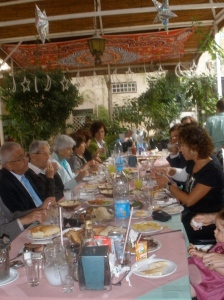For all special occasions, Fatima prides herself on the kibbeh she makes. That makes her like many women in the Middle East who have mastered the art of this rather complex food.
In my family, like so many extended families, no party is ever complete without a platter of my Aunt Suad’s kibbeh, which is a Middle Eastern mixture of finely ground bulgar, onion, and lamb or beef that is, most commonly, formed into a patty or ball, stuffed with cinnamon and sumac-spiked meat, then fried, baked, or grilled. When people ask Fatima what the secret to good kibbeh is, she holds up her hands: It is believed that the thinner the shell, the better the kibbeh, and legend goes long fingers are particularly prized to carefully form a thin enough outer layer to envelop but not overshadow the flavorful, moist center. In fact, the word kibbeh actually derives from the Arabic verb kebkeb “to shape.”
Often called the national dish of Lebanon and Syria, kibbeh is one of the most versatile concepts in Middle Eastern cookery, and recipes for it have existed for centuries, when the addition of bulgar to meat may have been a way to make the precious commodity last longer. (It is also made with fish in Iraq). In villages across the Levant, the preparation of kibbeh was once a communal event, and the sound of the pounding together of meat and bulgar in huge mortars could be heard throughout small towns. Today kibbeh is, for the most part, prepared by home cooks or in restaurants and it comes in many forms. To save time some people simply spread the mixture in a tray and bake it. As a main dish, kibbeh is frequently simmered in mint-laced yogurt, and as an appetizer or, as Miriam does for Rock’s birthday, it is often served tartare-style, drizzled with olive oil, sprinkled with mint, and scooped up with raw onion wedges. But it is the crispy, warm, deep-fried kibbeh (aqras kibbeh maqliyya) that is most often served to guests, not only as part of the mezze at Arabic restaurants, but also an essential part of the buffet at weddings, family gatherings, and other festive occasions throughout the Middle East.
I’ve given you a recipe below, but I warn you that preparation is time consuming!
KIBBEH
1 kilo high quality, very lean beef or lamb (if lamb, lean leg of lamb is
best)
1 kilo fine ground bulgar wheat
1 medium onion.
2 T salt
1 t. allspice
1 t. cinnamon
1/2 t. black pepper
1 C. cold water
STUFFING:
2 medium-size onions chopped
1/2 kilo ground sirloin
1/2t. allspice
1/2 t. cinnamon
salt to taste
2 T. sumac
1/4 c. olive oil
1/2 c. pine nuts or chopped walnuts
Shell: Rinse the bulgar wheat with water and squeeze out water. Grind the meat in an electric mixer twice. Finely chop the onion. Mix the spices with the onion. Knead the meat, bulgar wheat, and onion together with your hands then put
through the electric grinder once. Gradually add the cold water to the mixture kneading until it is smooth and pliable like bread dough (you may not need all the water). Cover the kibbeh with cloth towel so that it does not dry out.
Stuffing: Sautee the onion in the oil until soft and translucent. Add the ground meat and cook through, 10 to 15 minutes. Add cinnamon, allspice, and salt to meat a couple minutes before it is done browning. Take off heat and mix in nuts and sumac. When stuffing is cool enough to work with, you may begin making the kibbeh.
Form the kibbe “dough” into balls the size of an egg. Keep them covered
with a towel, so they do not dry out. Form each “egg” into an oval shell by inserting your index finger into the “egg” and turning it around until it forms a thin oval with an open end. Use your other hand to hold the kibbeh as you turn. Dip your fingers in cold water to help prevent the kibbeh from breaking. Take a teaspoonful of the stuffing and put into the shell. Seal the shell. Do this with remaining “eggs,” keeping everything covered so it does not dry out.
Deep fry the balls in hot oil for a few minutes, until they turn a dark,
golden brown (a color halfway between dark brown sugar and light brown
sugar)
Put on paper towel to drain. Serve at room temperature with yogurt on the
side, if desired.
This recipe should make about 20.
Fatima’s Freezing Tip: It is bet to freeze the kibbeh before frying it, and fry it a
few hours before serving.


Your book was our book club choice this month and as usual we themed the food to the book. Such great material. We really enjoyed the discussion and our Lebanese feast (just down the road from you in Dubai).
I posted the food element in case you are interested, and thanks for the Christmas cake blog–I love that stuff!
LikeLike
Dear Sally, Thank you for telling me this–and thank you for the link to your website. Yummy meal you had! Believe it or not, as a foodie, I’ve come across your site before, and so I’m delighted that “The Night Counter” made it there. In case you’re interested, I also put a “cookbook” from the novel up on the website: http://www.aliayunis.com
LikeLike